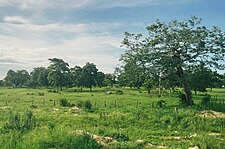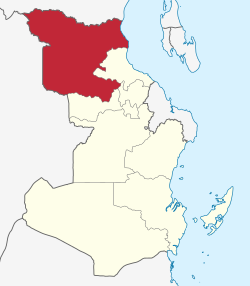| Chalinze District Wilaya ya Chalinze (Swahili) | |
|---|---|
| District of Pwani | |
   From top to bottom:
From top to bottom:Mbwewe Landscape in Chalinze DC, Chalinze District Capital Building in Bwiligu and Vigwaza landscape of chalinze District | |
| Nickname: Home of the Saadani National Park | |
 Chalinze District in Pwani Chalinze District in Pwani | |
| Coordinates: 6°38′18.96″S 38°21′7.56″E / 6.6386000°S 38.3521000°E / -6.6386000; 38.3521000 | |
| Country | |
| Region | Pwani Region |
| Named for | Chalinze ward |
| Capital | Bwilingu |
| Area | |
| • Total | 8,042 km (3,105 sq mi) |
| • Rank | 3rd in Pwani |
| Population | |
| • Total | 316,759 |
| • Rank | 3rd in Pwani |
| • Density | 39/km (100/sq mi) |
| Demonym | Chalinzean |
| Ethnic groups | |
| • Settler | Swahili |
| • Native | Kwere, Doe people, Zaramo & Zigua |
| Website | Chalinze District Council |
| Symbols of Tanzania | |
| Bird | |
| Fish | |
| Mammal | |
Chalinze District Council (Wilaya ya Chalinze in Swahili) is one of nine administrative districts of Pwani Region in Tanzania. The district covers an area of 8,042 km (3,105 sq mi). The district is comparable in size to the land area of Puerto Rico. Chalinze District is bordered to the northeast by Pangani District, the north by Handeni District and in Kilindi District of Tanga Region. The district is bordered to the east by the Indian Ocean. Chalinze is also borders Bagamoyo District, Kibaha Urban District and to the South by Kibaha District. On the western part, the district is bordered by Mvomero District and Morogoro Rural District of Morogoro Region.
The district seat (capital) is the town and ward of Bwilingu. The district is named after the town of Chalinze itself. The district is home to Tanzania's 5th President, Jakaya Kikwete, who was born and raised in Msoga, Chalinze District. He was also a member of parliament of the district during his political career. The district was created from Bagamoyo District in July 2016. In addition, the district is home to the southern portion of Saadani National Park, which is the only terrestrial national park in the country next to the ocean. According to the 2012 census, the district has a total population of 214,080. by 2022, the population had grown to 316,759.
Administrative subdivisions
As of 2016, Chalinze District was administratively divided into 16 wards.
Wards
|
|
Geography
Climate
Chalinze's climate falls under subtype "Aw" of the Koppen Climate Classification. (Climate of a Tropical Savanna). Chalinze's yearly average temperature is 78.4 °F (25.8 °C). The average temperature for the warmest month is 82.0 °F (27.8 °C) in February. July has the lowest average temperature of any month, at 74.3 °F (23.5 °C). Chalinze experiences 37.5" of precipitation on average per year (952.5 mm). With an average rainfall of 8.0" (203.2 mm), April is the month with the most precipitation. July has an average of 0.6" of precipitation, making it the month with the least amount (15.2 mm). The average number of days with precipitation is 108.0, with 16.3 days in April recording the highest total and June recording the lowest total.
| Climate data for Chalinze | |||||||||||||
|---|---|---|---|---|---|---|---|---|---|---|---|---|---|
| Month | Jan | Feb | Mar | Apr | May | Jun | Jul | Aug | Sep | Oct | Nov | Dec | Year |
| Mean daily maximum °C (°F) | 33 (92) |
34 (93) |
33 (91) |
31 (87) |
29 (85) |
29 (84) |
29 (85) |
31 (87) |
32 (89) |
33 (91) |
33 (91) |
33 (91) |
33 (91) |
| Mean daily minimum °C (°F) | 23 (74) |
23 (73) |
23 (73) |
22 (71) |
21 (69) |
18 (65) |
18 (64) |
18 (64) |
18 (65) |
20 (68) |
21 (70) |
23 (73) |
18 (65) |
| Average precipitation mm (inches) | 80.7 (3.18) |
80.7 (3.18) |
124.8 (4.91) |
204.4 (8.05) |
94.1 (3.70) |
25.7 (1.01) |
16.2 (0.64) |
18.9 (0.74) |
40.6 (1.60) |
65.7 (2.59) |
97.5 (3.84) |
103 (4.1) |
952.3 (37.49) |
| Source 1: Weatherbase | |||||||||||||
| Source 2: Weatherspark | |||||||||||||
History
The area that is now Chalinze District has been inhabited by humans for thousands of years by Bantu peoples. The area is the ancestral home to three Bantu people groups, namely the Kwere, Doe people and the Zigua. The Zaramo are native to the southern portion of the district.
Education & Health
As of 2022, there were 142 Schools in Chalinze District, 112 of are primary schools and 30 are secondary schools. In Terms of Healthcare facilities, as of 2022 Chalinze district is home to 5 health centers and 39 clinics.
References
- "Chalinze District".
- 8,870 km (3,420 sq mi) for Puerto Rico at "Area size comparison". Nation master. 2022. Retrieved 7 July 2022.
- "Chalinze District".
- "2012 Population and Housing Census General Report" (PDF). Government of Tanzania. Archived from the original (PDF) on 2022-03-26. Retrieved 2022-06-10.
- "Tanzania: Administrative Division (Regions and Districts) - Population Statistics, Charts and Map". www.citypopulation.de. Retrieved 2024-02-11.
- "Weatherbase: Weather and Climate summary of Chalinze". Weatherbase. 2022.
- "Weatherbase: Historical Weather for Chalinze, Tanzania". Weatherbase. 2022. Retrieved on 10 Jul 2022
- "Weatherspark: Historical Weather for Chalinze, Tanzania". Weatherspark. 2022. Retrieved on 10 Jul 2022
- "Chalinze District Council". Retrieved 2022-06-11.
- "Education Chalinze District Council". Retrieved 2022-06-11.
- "Health Chalinze District Council". Retrieved 2022-06-11.
| Chalinze District | |
|---|---|
| Capital: Bwilingu | |
| Wards | |
| Native Peoples | |
| Rivers and Lakes | |
| Major Cities and Towns | |
| National Parks and Reserves | |
| Pwani Region | |
|---|---|
| Capital: Kibaha | |
| Districts | |
| Native Peoples | |
| National Historic Sites | |
| Islands | |
| Rivers and Lakes |
|
| Major Cities and Towns |
|
| National Parks and Reserves |
|
| Landmarks of Pwani | |
| Heritage Monuments of Pwani |
|


